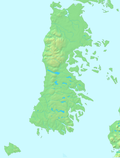Red tide crisis in Chiloé

The red tide crisis in Chiloé, also known as "Chilote May" (Spanish: Mayo chilote), was a social, economic and environmental catastrophe that occurred in the Chiloé Archipelago, southern Chile, in the southern autumn of 2016, as a result of a severe algal bloom of the dinoflagellate Alexandrium catenella — a microalgae responsible for the phenomenon known as red tide. The bloom spanned the months of March and April and affected the outer sea of the Los Lagos Region, the inland coast of Chiloé, and the Chacao Channel. It affected thousands of artisanal fishermen on the Chiloé Island —in addition to other communes such as Calbuco, Maullín and Puerto Montt (the regional capital) because they prohibited from extracting marine resources due to widsepread contamination with paralytic shellfish poison (PSP).
The severe economic effects and the poor response provided by the administration of Michelle Bachelet —as well as the controversial dumping of more than 4,600 tons of decomposing salmon off the coast of Chiloé, carried out in March by the salmon industry with the authorization of the Government—provoked a social mobilization unprecedented in the history of Chiloé, which, by blocking routes and maritime access to the island, kept the archipelago paralyzed and isolated from the mainland for eighteen days —between the 2nd and the 19th of may-. The blockades and protests would end after all the mobilized communes reached agreements with the Government on economic aid,[1][2] but the ban on extracting resources would remain in place for several months in various areas of the region, due to the presence of toxins.
The crisis generated harsh questions about the role of the Government during the emergency, as well as the salmon industry for its role in the emergency and the alleged impact of its operation on the environment.
Causes
A widely circulated theory blames the crisis on actions of the Chilean salmon industry. The theory links the emergence or severity to the dumping of 40,000 tons of dead salmon in the northern part of the Sea of Chiloé.[3] These salmon had died during a previous "brown tide" outbreak of Pseudochattonella verruculosa.[3] A later study about near-surface currents in the Sea of Chiloé during May 2016 claimed it is likely that currents spread the waters where the decomposing fish had been dumped towards the shore of Chiloé Island.[3]
A link to the 2015-2016 El Niño event, reportedly "one of the strongest such events in the last 50 years," has been suggested by Leonardo Guzmán, the chief of the Aquaculture Division of the Fisheries Development Institute.[4]
Some scientists have suggested an influence of the large April 2015 eruption of Calbuco Volcano, as it would have added components to waters.[5] This influence was dismissed by the National Geology and Mining Service with the argument that most volcanic ash of the eruption spread east and fell in Argentina.[6]
References
- ^ Burgos Sepúlveda, Eduardo (2016-05-16). "Ancud firmó acuerdo y terminó histórica movilización chilota". La Estrella de Chiloé. Castro. p. 2. Retrieved 2021-07-25.
- ^ Marín, Verónica (2016-05-20). "Alcaldes de Chiloé esperan que normalización se concrete el lunes tras el fin de las movilizaciones". Emol. Santiago.
- ^ a b c Armijo, Julien; Oerder, Vera; Auger, Pierre-Amaël; Bravo, Ángela; Molina, Ernesto (2020). "The 2016 red tide crisis in southern Chile: Possible influence of the mass oceanic dumping of dead salmons" (PDF). Marine Pollution Bulletin. 150. doi:10.1016/j.marpolbul.2019.110603.
- ^ "Jefe del IFOP asegura que no existe relación entre vertimiento de salmones y marea roja". Aqua.cl (in Spanish). 2016-05-02. Retrieved 2023-06-07.
- ^ "Científico plantea posible impacto de volcán Calbuco en marea roja". La Tercera (in Spanish). 2016-05-06. Retrieved 2023-06-07.
- ^ "Marea Roja: Sernageomin descarta supuesta relación con la erupción del Calbuco en 2015". Teletrece (in Spanish). 2016-05-10. Retrieved 2023-06-07.
